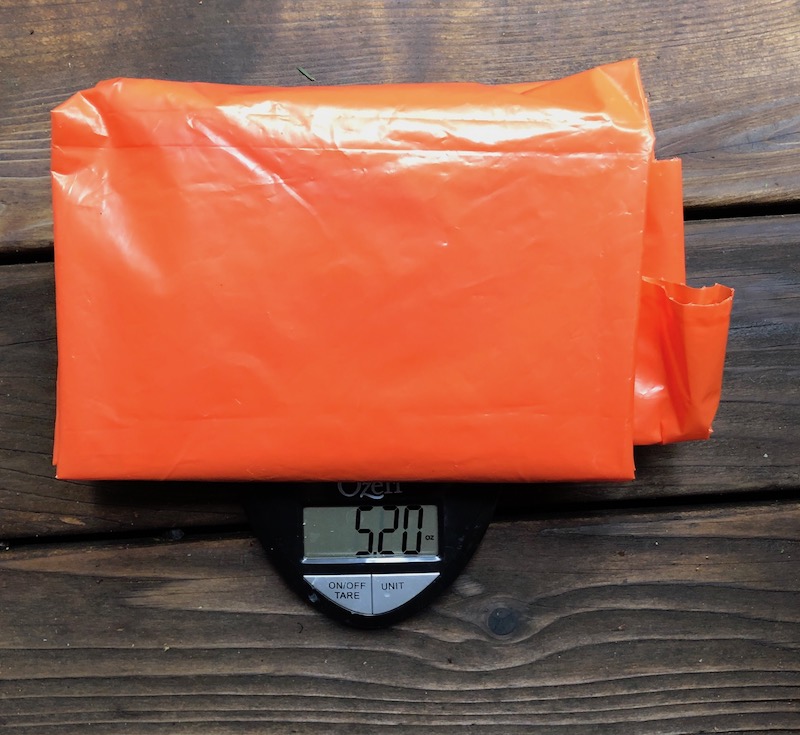Survival shelter for an unexpected night out
In the book “Analysis of Lost Person Behavior” author William Syrotuck analyzed over 200 rescue cases. He found that 11% ended in fatalities, and three quarters of those people who died generally did so from hypothermia, within the first 48 hours of becoming lost.
So, to look at these statistics in a more positive way:
If you’re lost, you have an approximately 90% chance of surviving.
If you can stay alive for 2 days and minimize the chances of getting hypothermia, your survival odds increase to around 97%.
This tells us that carrying some kind of emergency shelter is an excellent idea.
But what, exactly does that mean? A one person tent, a tarp, a bivy sack, maybe even a bothy bag, which is kind of a British combination of all three? Or something more minimal?
If you have a reasonable chance of spending a night out, you probably want something fairly substantial, like a bivy sack and tarp. But, if you're after something to keep in your hiking day pack for emergency use only, something lighter which takes up less space is probably a better choice.
For emergency use, go with simple: a heavy duty garbage bag. Cost: about $1, weight, about 5 ounces / 140 grams.
As a survival shelter, cut a small slit in the side end for your head, see the video below. If you're about average height, you can probably crouch over and get most of your whole body inside the bag. If you're tall than that, you might want to bring two bags, one for your feet and one for your torso and head.
Also, the bag serves as a rain cover for your pack, and easily converted into a poncho if you cut a hole for your neck and arms.
Be sure and get the heavy duty “contractor clean-up bags”, that are huge (typically 43 gallons) and 3 mil thick. (Side note: a “mil” means one 1000th of an inch, and is a standard in the United States for measuring the thickness of plastic. It’s not a millimeter or a milliliter.)
At the big box hardware stores, you usually need to buy a humongo box of 50 of these, so if you know anyone who’s a builder you could ask them for a couple of extras. Or, they’re available on Amazon as a more reasonably sized box of 20.
After some hunting around, I was able to find some that are orange, better for increased visibility, unfortunately available in a pack of 50. So I've been sharing them with various climbing friends and students over the years. Try a Google for “orange 3 mil 42 gallon contractor trash bags". I found mine from plasticplace.com.
Many backpacks have a water bladder pocket, or maybe a pocket to hold a foam pad as part of the suspension. You can slip the bag in this pocket; you're not notice the weight and it’ll always be in your backpack.
These are the bags I got from Amazon:
Here is a nice short video from the excellent MedWild YouTube channel on making a quick emergency shelter with a garbage bag. Note that he cuts just a small hole in the SIDE of the bag, which lets you breathe and see, but keeps your head protected.
Many people want to cut a hole for your head in the top of the bag, which keeps your head exposed. The hole in the side is much better. Here's a screen grab from the video showing this simple technique.
image: https://www.youtube.com/watch?v=baTeliYY9lc&feature=youtu.be
And here's the whole video:
What about mylar “space” blankets or mylar bivy sacks?
Lots of people carry these for emergency use. But they have a few issues:
Yes, they can reflect some of your body heat back, but if you're getting hypothermic, there's not much heat being generated in the first place. If you have proper clothing on, that should be doing its job of keeping heat close to your body.
If you have the mylar against your bare skin, the blanket will conduct the heat away from you into the cold air. The same thing happens if you put it on bare ground, heat conductivity from your butt into the earth.
The very inexpensive ones are extremely fragile and start ripping if you sneeze on them, so don't even bother buying those.
Most emergency bivy sacks are pretty much non-breathable, so you can expect to get a fair amount of condensation and wetness inside your bag. The advantage to the garbage bag is that you can get a bit of airflow from your feet up through your head, which minimizes condensation.
Given the choice between a garbage bag and a mylar space blanket, take the garbage bag.
The mylar blankets and bags may not be very good when used by themselves, but they do have some other wilderness survival applications. If you do choose to take one, spend just a few extra bucks and get one of good quality that's much sturdier. SOL makes some nice ones, called Heat Sheets. They cost just about $10 for a 2 pack.




